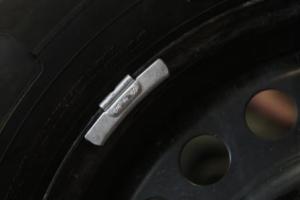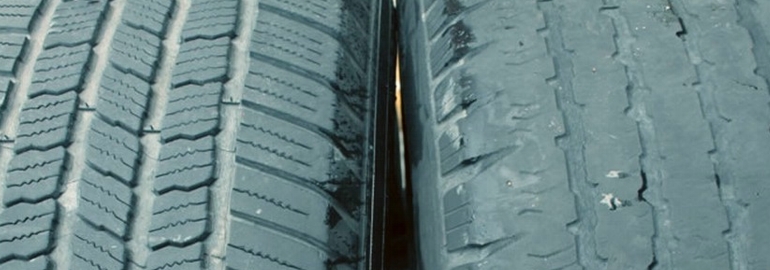Tire Balancing Long Beach, CA 90805
Avoid costly and uneven tire wear with proper wheel and tire balancing
Every time a tire is mounted onto a wheel – and then onto your car’s axle – the tire has to be balanced. Tire balancing is a process where a piece of equipment – a tire balancing machine – determines where additional weight should be added to your tire to make it rotate without vibration.
It’s important to know that as little as ¼ ounce difference in weight around the wheel. You’re probably asking “Why worry about that small amount of weight on a car tire or wheel?

Typical tire balancing weight shown (silver) clips onto or mounts onto the wheel rim assuring proper wheel and tire balance
The facts are that your wheel travels at fairly high speeds – rotating several hundred times per minute. That small – often thought of as insignificant amount of weight – created enough moment to cause serious damage.
Then multiply that by four wheels – and result could be very dangerous.
Tires and wheels that are not properly balanced could cause annoying vibration – but what’s worse is that unbalanced tire can lead to more costly damage and repairs.
Unbalanced tires put uneven pressure on the treads of the tire. As you drive, the tires get too hot in some spots – and that causes uneven tire wear.
Tires that are not properly balanced can also strain the wheel bearings and some of the suspension components of your car.
How Often Should I Get Tires Balanced
How do I know if my tires should be balanced? Wondering “How Often should I Get Tires Balanced?
Understand that tire balancing isn’t a “one and done” service. The moment you drive away from the service station that just balanced your tires – the newly balanced tires begin getting out of balance again.
That’s because every corner, bump and turn can effect tire balance. Over time, your tires will get out of balance again, no matter how carefully you drive.
For those reasons, it’s important to have your tires balanced on a regular basis.
Under typical use and driving conditions, it’s a good idea to have your tires rotated and balanced every 4,000 to 6,000 miles. In addition to that, your tires should be balanced any time a tire is replaced or when a leak is repaired or patched.
What are the warning signs that my tires aren’t balanced?
Tire balance is typically not something you can check visually. However, should you begin to notice uneven wear on your tires, it’s an indication that tire balance should be checked and corrected.
Additionally, in most cases, an unbalanced tire will produce a vibration at speeds of over 40 mph. The vibration becomes even more noticeable if the unbalanced tire is on the front of the car.
Other visitors looking at Tire Balancing wanted to…
Book An AppointmentGet CouponsFind Us FastAsk A MechanicSee Our Auto ServicesRead Customer Reviews
Tire Balancing vs Alignment
Wondering About the Difference Between Tire Balancing vs Alignment? Not sure if your car needs the tires balanced or if you should have a wheel alignment?
Alignment is often confused with tire balancing, but they are not the same. Your vehicle could just need a simple tire balancing and not a more costly wheel alignment.
Alignment or wheel alignment is the process of making sure all the wheels on your car are set to the proper angles according to the manufacturer’s specifications.
When it comes to alignment, those angles mean the CAMBER, CASTER and TOE.
Typically, you would have a problem with the wheel alignment of your car if, when driving on a straight and level road, you loosen your grip on the steering wheel and your car pulls towards one site or the other. Although that’s not the definitive test for alignment – it’s one just about anyone can do while driving.
From the chart, poor wheel alignment also leads to uneven tire wear as pictured.
On the other hand, wheel or tire balancing usually leads to a problem that is speed related. In other words, you don’t feel a vibration at slow speeds or city driving – but you DO feel a vibration at speeds over 40 mph.
It should also be noted that in some cases, the wheel vibration may go away as you continue to increase speed. That’s all dependent on how the wheel and tire is out of balance and by how much.
Other visitors viewing Tire Balancing Also wanted to…
Book An AppointmentGet CouponsFind Us Fast Ask A MechanicSee Our Auto ServicesRead Customer Reviews
Tire Balancing vs Tire Rotation
Are you wondering about the difference between Tire Balancing vs Tire Rotation?
Tires are typically rotated on a regular basis – usually recommended every second oil change – to avoid uneven wear.
The purpose of tire rotation is so that the tread wear is evened out.
It’s important to understand that as you drive, the tires on the front of your vehicle do different duties than the tires on the back. Front tires are typically responsible for cornering and turning – and therefore do somewhat more work.
On the other hand, the tires on the back of your car basically follow the front tires.
Rotating or moving those tires to the back provides a bit of a ‘rest’ while reducing the amount of wear and tear they experience.
The back tires – the ones usually less strained during normal driving – are positioned to the front.
Most tire rotations will involve rotating the tires from front to back. However, depending on your vehicle and the specific tire manufacturer, they may recommend a specific cross pattern for tire rotation and it could even include the spare tire. Check your owner’s manual for the specific tire rotation pattern for your car.
The one shown here is a typical ‘rule of thumb’ that most follow.




